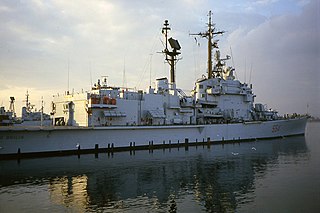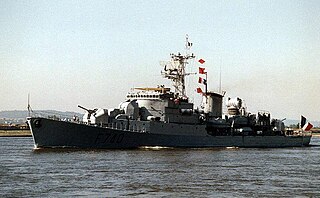
Caio Duilio was an Andrea Doria-class helicopter cruiser of the Marina Militare. Built by Navalmeccanica at Castellammare di Stabia, it was named after the Roman consul Gaius Duilius.

HMS Rothesay was the lead ship of the Rothesay or Type 12M class of anti-submarine frigates of the British Royal Navy. She was commissioned in 1960 and scrapped in 1988.

HMS Londonderry was a Rothesay- or Type 12-class anti-submarine frigate of the British Royal Navy in service from 1960 to 1984.

HMS Brighton was a Rothesay or Type 12I class anti-submarine frigate of the Royal Navy.

HMS Lowestoft was a Rothesay-class or Type 12 class anti-submarine frigate of the British Royal Navy. Lowestoft was reconstructed in the late 1960s to largely the same pattern as the third group of Leander-class frigates, with new radar and fire control and a hangar and pad for a Westland Wasp helicopter for longer range, anti-submarine, engagement. In the late 1970s it was converted as the prototype towed array frigate for the Royal Navy, but retained its full armament. Lowestoft was sunk as a target on 8 June 1986 by HMS Conqueror using a Tigerfish torpedo. She was the last Royal Naval target to be sunk still displaying her pennant number.

The Impavido class were the second group of destroyers built for the Italian Navy after World War II and the first Italian guided missile destroyers. Similar in performance to the US Navy's Charles F. Adams class, these ships were essentially improved Impetuoso-class vessels, with the after gun-turret being replaced by a Tartar surface-to-air-missile launcher and associated radar.

The Commandant Rivière class was a class of frigates built for the French Navy in the late 1950s and early 1960s. Labeled "aviso-escorteur", they were designed to perform the role of overseas patrol in peacetime and anti-submarine escort in wartime. This vessel class is named after the French Navy officer Henri Rivière (1827–1883).

The Cassiopea class is a heavy series of four patrol boats of the Italian Navy. They were built in the late 1980s on civilian standards. They are designed for patrol in safe areas.

The Alpino class were a group of two frigates built for the Italian Navy during the Cold War.

The Le Normand class was a class of 14 fast frigates built for the French Navy in the late 1950s. They were an immediate follow-on from the earlier Le Corse-class frigates, and like them, were long-range convoy escorts capable of high speed. The first seven ships, paid for by the United States under the Mutual Defense Assistance Act were ordered in 1952. The remaining seven ships were paid for by France and ordered between 1953 and 1955.

The Dealey-class destroyer escorts were the first post-World War II escort ships built for the United States Navy.

The Albatros class was a class of eight corvettes designed and built in Italy in the 1950s. Paid for by US funds, they were operated by Italy, Denmark, Indonesia and the Netherlands. The last ships of the class were retired from service in Italy in 1991.
INS Brahmaputra (F31) was a Leopard-class frigate of the Indian Navy. She was built by the Scottish shipbuilder John Brown & Company and completed in March 1958. Brahmaputra served during the Indo-Pakistani War of 1965 and the Indo-Pakistani War of 1971. She was scrapped in 1986.

The Audaz class was a class of nine destroyers built for the Spanish Navy after the Second World War. Construction was slow, with only four completed to the original design from 1953–1956. The remaining five ships completed as anti-submarine escorts with a new armament and sensor fit from 1960 to 1965, while the original four ships were also modified to this standard. Built at Ferrol, they completed in 1946–1950 and were rated as gunboats, and were redesignated as frigates in 1959. The last of the class, Intrepido, was stricken in 1982.
The Pizzaro class was a class of eight escort vessels built for the Spanish Navy in the 1940s. Built at Ferrol, they were completed in 1946–1950 rated as gunboats, and were redesignated as frigates in 1959. They started to be withdrawn from use in 1968, with the last of the class, Vincente Yañez Pinzon, stricken in 1982.

Intrepido(D 571) is the second ship of the Impavido-class destroyer of the Italian Navy.

Carlo Bergamini(F 593) was the lead ship of the Bergamini-class frigate of the Italian Navy.

Virginio Fasan(F 594) was a Bergamini-class frigate of the Italian Navy.

Carlo Margottini(F 595) was a Bergamini-class frigate of the Italian Navy.

Luigi Rizzo(F 596) was a Bergamini-class frigate of the Italian Navy.



















